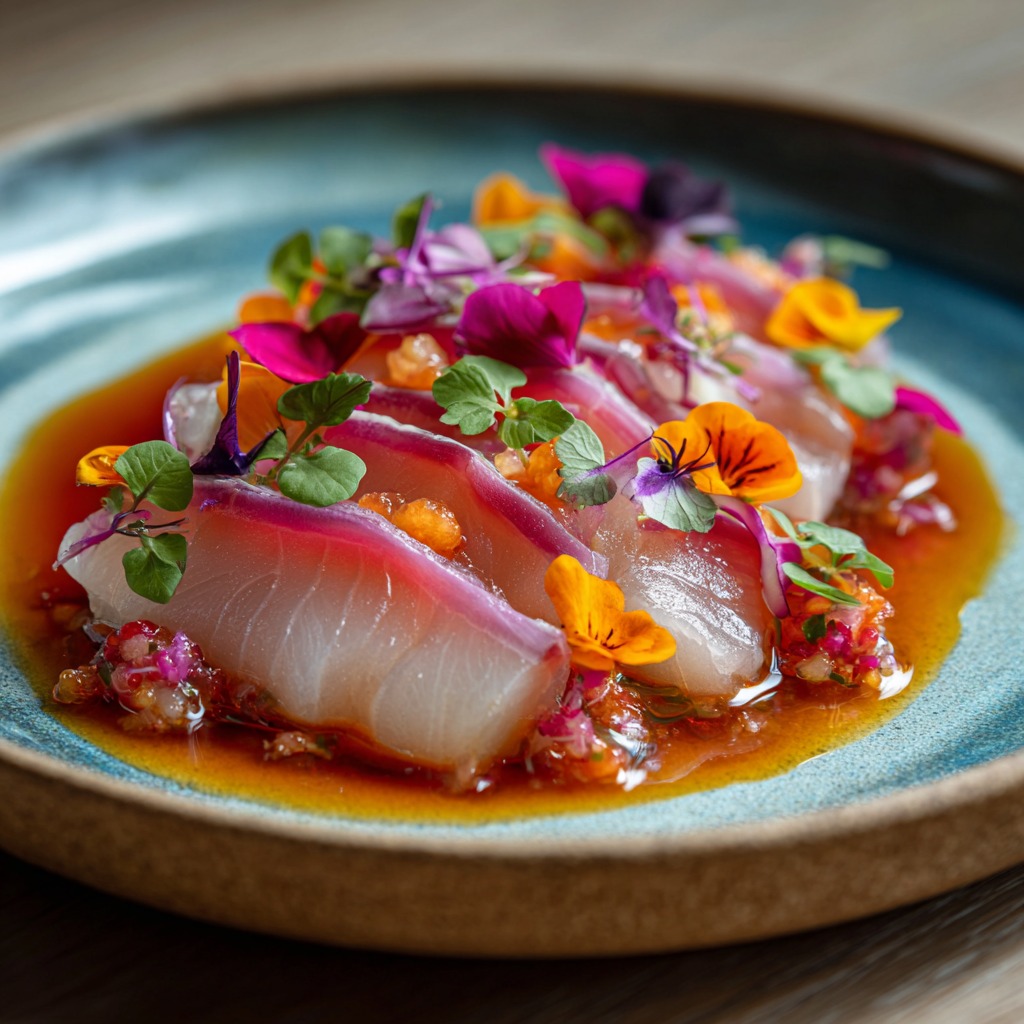Hamachi Crudo Recipe is a sophisticated and stylish dish highlighting the innate qualities of unprocessed seafood. In this Japanese dish, finely sliced yellowtail, or hamachi, is present, covered by a gentle trace of non-extra virgin olive oil, enhanced by the juice of a fresh citrus, and served with a pinch of dry condiment. Amid the growing devotion toward this dish among the seafood sustainability advocates is the ability, if only for the briefest of moments, to worship a seafood in its rawest form.
It is a dish that is as reverent in its devotion to eating as it is in serving. It gets the heart warmed, for only a fine restaurant serves hamachi crudo in megas, with people relishing it in their own homes.
Hamachi crudo, texturally and flavorfully, is a crossing of multiple delights. Citrus and olive oil in unison dilute the lovely and butter-loaded richness of hamachi and evade the danger of hamachi gluttony. Each bite enchants the palate with wholesome raw umami, blending the spicy (especially if chili is added) and the fresh in a gentle heat. Hamachi crudo represents the touch of verve in serving ornate culinary delights. It is a verve for the functional marvel in serving the simplest of pleasures, leaving the person served utterly fulfilled.
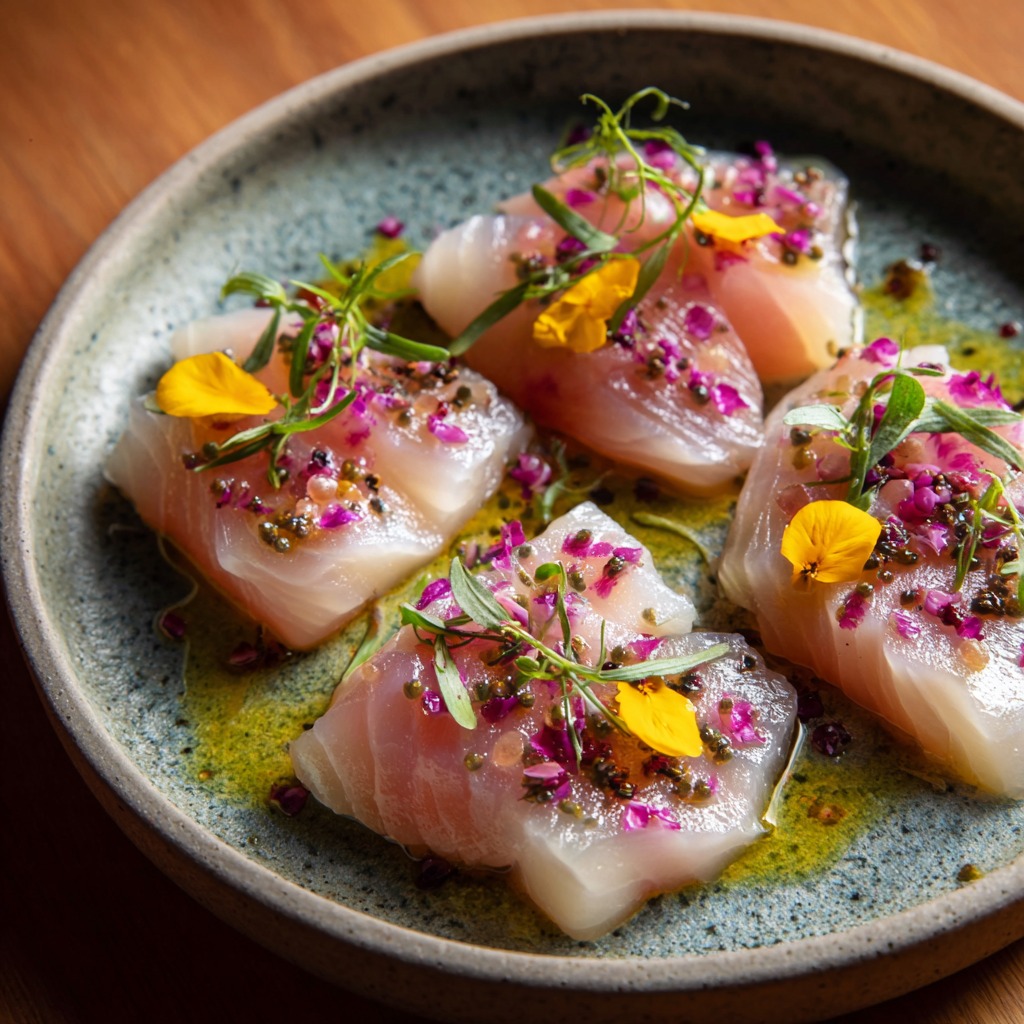
This hamachi crudo is an excellent option for a small, light starter or a refreshing way to begin any meal. It is very quick to prepare, needs very few ingredients, and has beautiful end results. This dish is excellent for any size occasion, whether you are entertaining friends or want a quick, healthy dish to enjoy. This is a great dish to showcase. Let’s look at the details on how to prepare hamachi crudo at home.
- What is Hamachi Crudo?
- Ingredients for Hamachi Crudo Recipe
- How to Make Hamachi Crudo Recipe
- Common Mistakes to Avoid in Hamachi Crudo Recipe
- Serving and Pairing Hamachi Crudo Recipe
- Health Benefits of Hamachi Crudo
- Variations of Hamachi Crudo to Try
- Frequently Asked Questions About Hamachi Crudo
- Conclusion
What is Hamachi Crudo?
The Basics of Hamachi Crudo Recipe
At its most foundational level, hamachi crudo is a dish of thinly sliced yellowtail (hamachi), a Japanese fish, served raw and often garnished with a citrus fruit, oil, and various seasonings. Crudo is the Italian word translated to “raw”, and in this culinary context, refers to fish or seafood served without cooking, effectively showcasing the dish’s primary characteristics to a greater extent.
Hamachi, as a species of yellowtail tuna, is recognized for its rich buttery texture and mild sweetness, which could contrast with the accompanying dish. The excessive leanness of the fish packs it to the mouth, making the dish significantly pungent with stiff acidity when combined with citrus fruit such as lime, lemon, or yuzu.
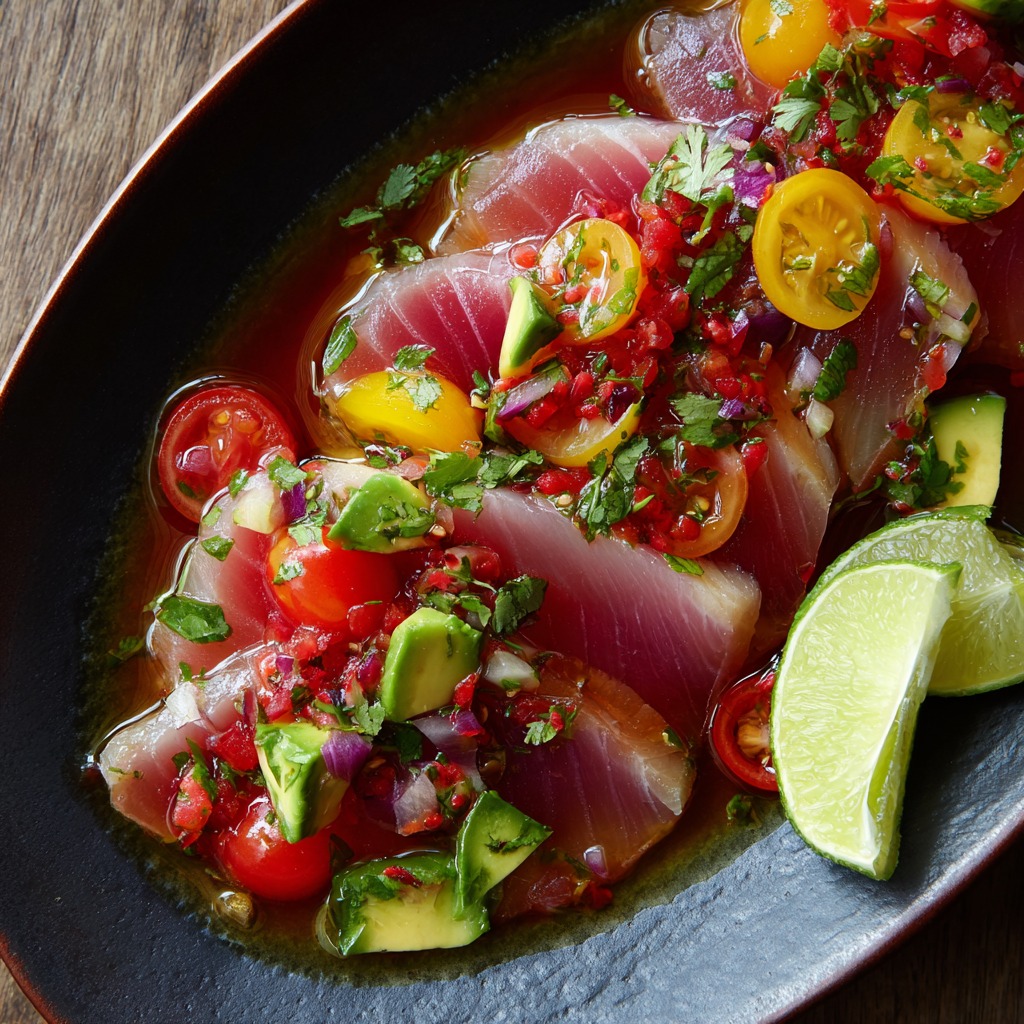
Hamachi vs. Other Types of Crudo
Although crudo may include tuna, snapper, and salmon, hamachi is known for its unique, pronounced flavors. Hamachi is milder and sweeter when compared to tuna. Hamachi’s rich, fatty texture enhances the multitude of seasonings used, making it an ideal candidate for crudo.
Here’s a quick comparison:
| Fish Type | Texture | Flavor Profile | Best for Crudo? |
|---|---|---|---|
| Hamachi | Buttery, fatty | Sweet, mild | Yes |
| Tuna | Firm, meaty | Bold, savory | Yes |
| Salmon | Soft, oily | Rich, slightly fishy | Yes |
| Snapper | Firm, lean | Mild, slightly sweet | Yes |
Ingredients for Hamachi Crudo Recipe
Fresh Hamachi Fish: What to Look For
The most crucial element in any hamachi crudo recipe is the fish itself. Freshness is key! Here’s what to look for when buying hamachi:
- Appearance: The fish should have translucent, moist flesh with no brown spots or discoloration.
- Smell: Fresh hamachi has a clean, ocean-like scent, not overly fishy.
- Source: When possible, opt for sustainably sourced hamachi, as this ensures both quality and environmental responsibility.
If fresh hamachi is hard to find, yellowtail tuna or snapper can serve as substitutes, though the texture and flavor may differ.
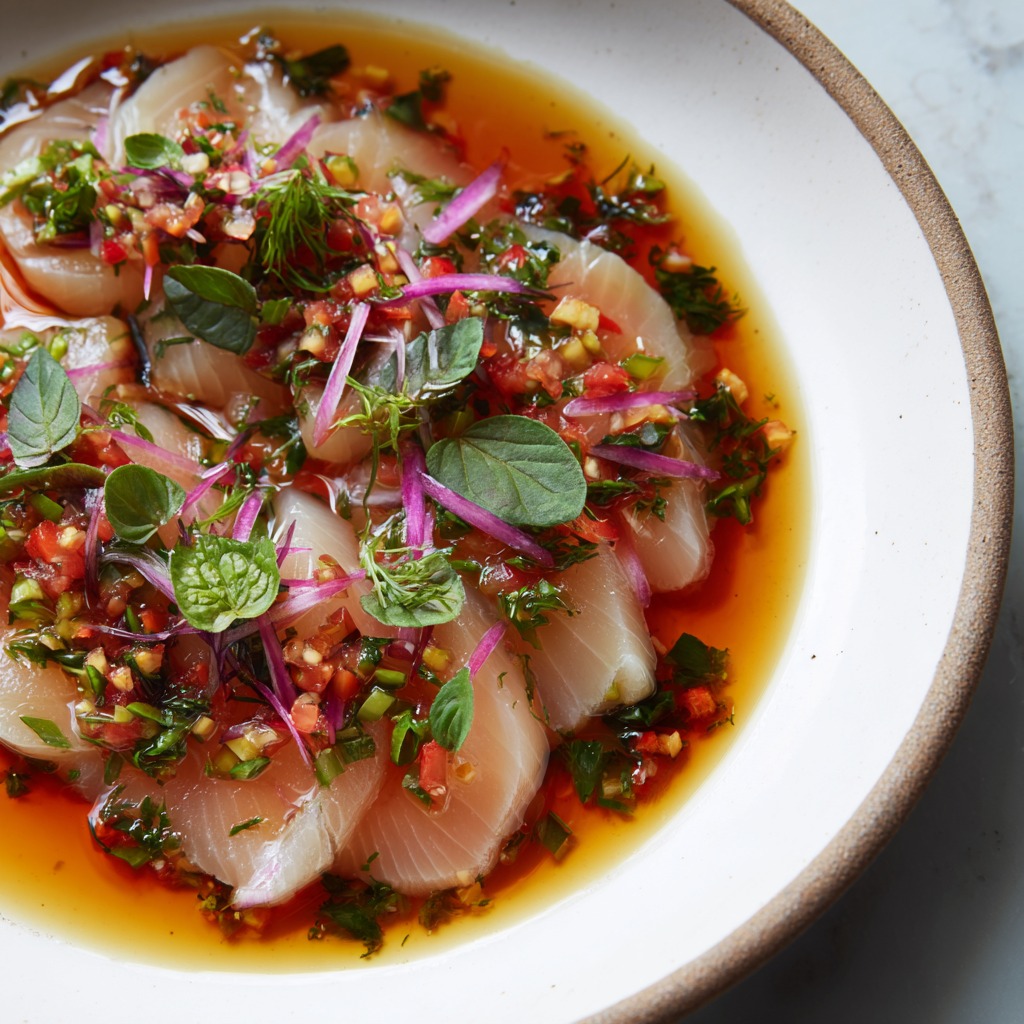
Essential Ingredients for the Perfect Hamachi Crudo Recipe
Aside from fresh fish, these ingredients are essential to create a flavorful hamachi crudo recipe:
- Olive Oil: A good-quality olive oil helps to bring everything together, adding smoothness and a rich depth of flavor.
- Citrus: Fresh lime or lemon juice is the go-to option for adding acidity and freshness. You can also experiment with yuzu, a Japanese citrus, for a more authentic touch.
- Sea Salt and Black Pepper: These basic seasonings enhance the natural flavors of the hamachi without overpowering it.
- Optional Toppings: Thinly sliced chili peppers for heat, fresh herbs like cilantro or basil, and microgreens for garnish add both flavor and texture.
Optional Add-ins for Extra Flavor
Ponzu Sauce: A Japanese sauce made from soy sauce, citrus, and vinegar, it adds umami depth to the dish.
Avocado: Adds a creamy texture and mild flavor that pairs beautifully with the fish.
Radishes: Their crunchy, slightly peppery flavor provides contrast to the softness of the hamachi.
How to Make Hamachi Crudo Recipe
Step-by-Step Hamachi Crudo Recipe
Follow these simple steps to create a mouthwatering hamachi crudo:
- Preparation:
- Begin by chilling the fish in the refrigerator to ensure the freshest taste and texture.
- Using a sharp knife, slice the hamachi thinly against the grain to create delicate, bite-sized pieces. Aim for about 1/4-inch slices for the ideal texture.
- Assembling the Dish:
- On a chilled plate, arrange the slices of hamachi in a circular pattern, fanning them out or overlapping them slightly.
- Seasoning:
- Drizzle with olive oil, a few spritzes of fresh citrus, and a pinch of sea salt and freshly cracked black pepper. This simple combination highlights the natural flavors of the fish.
- Adding Extras:
- For added complexity, you can drizzle a small amount of ponzu or soy sauce over the top, or scatter some finely sliced chili for a spicy kick.
- Garnishing:
- Top the dish with fresh herbs (like cilantro or mint), microgreens, or edible flowers for a colorful, visually appealing finish.
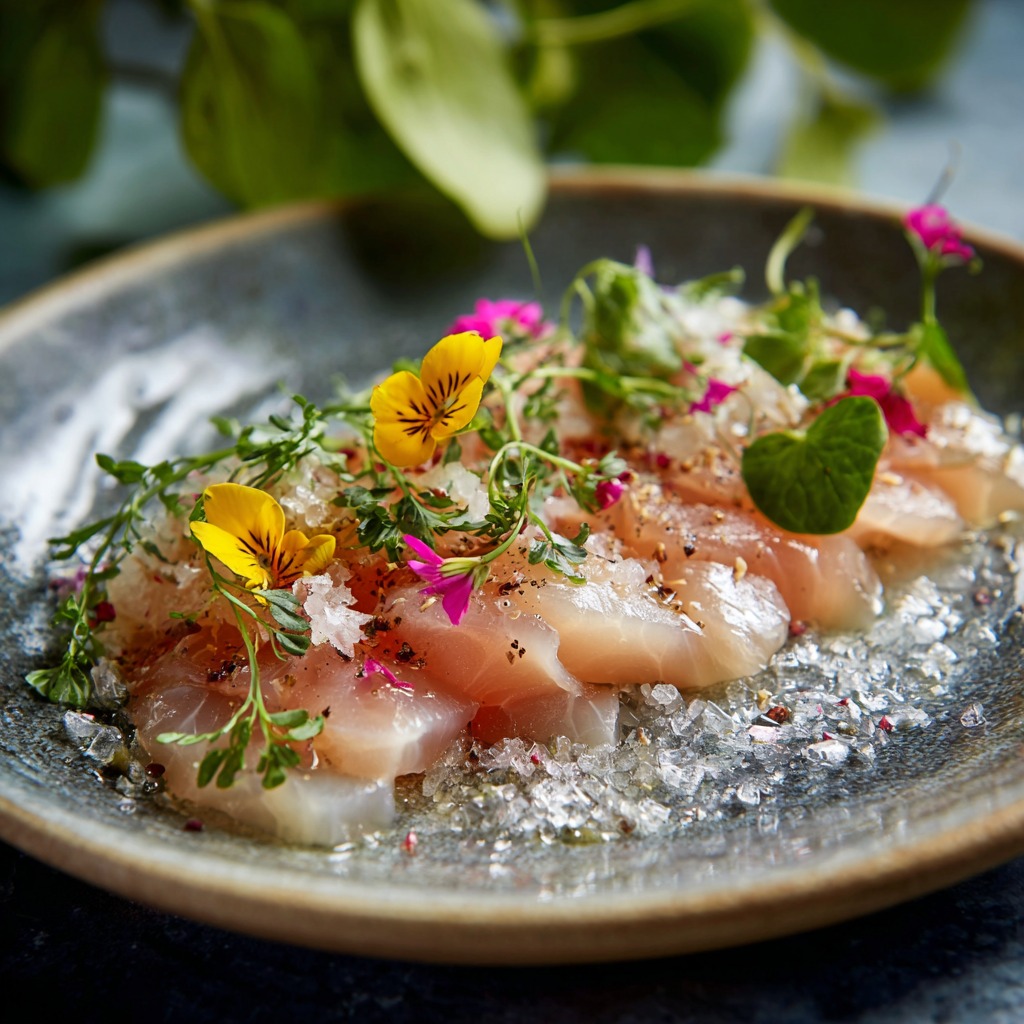
Tips for the Perfect Hamachi Crudo Recipe
Slice carefully: Aim for thin, even slices this makes the crudo more delicate and easy to eat.
Freshness is key: the fresher your hamachi, the better the dish will taste.
Don’t over-season: The fish should be the star, so keep the seasoning light and let the hamachi’s natural flavors shine.
Common Mistakes to Avoid in Hamachi Crudo Recipe
Using the Wrong Type of Fish
While hamachi is the best option for this dish, if it’s unavailable, tuna or snapper can be substituted. However, avoid using fish that’s too lean, like cod, as it may not provide the same richness needed for a crudo.
Over-seasoning or Under-seasoning
Finding the perfect balance is crucial. Too much salt can overpower the delicate flavor of the hamachi, while too little will make the dish bland. Always season lightly and taste as you go.
Improperly Slicing the Fish
For the ideal texture, slices should be thin and even. Avoid thick cuts, as they can be tough and chewy. Invest in a sharp knife for precise slicing.
Serving and Pairing Hamachi Crudo Recipe
Best Accompaniments for Hamachi Crudo Recipe
- Light Salads: A fresh green salad with a citrusy dressing complements the freshness of the crudo.
- Seafood Sides: Light seafood dishes like shrimp cocktails or scallop ceviche pair wonderfully.
- Bread: Serve with a crisp baguette or thinly sliced toast to balance the raw fish with a crunchy texture.
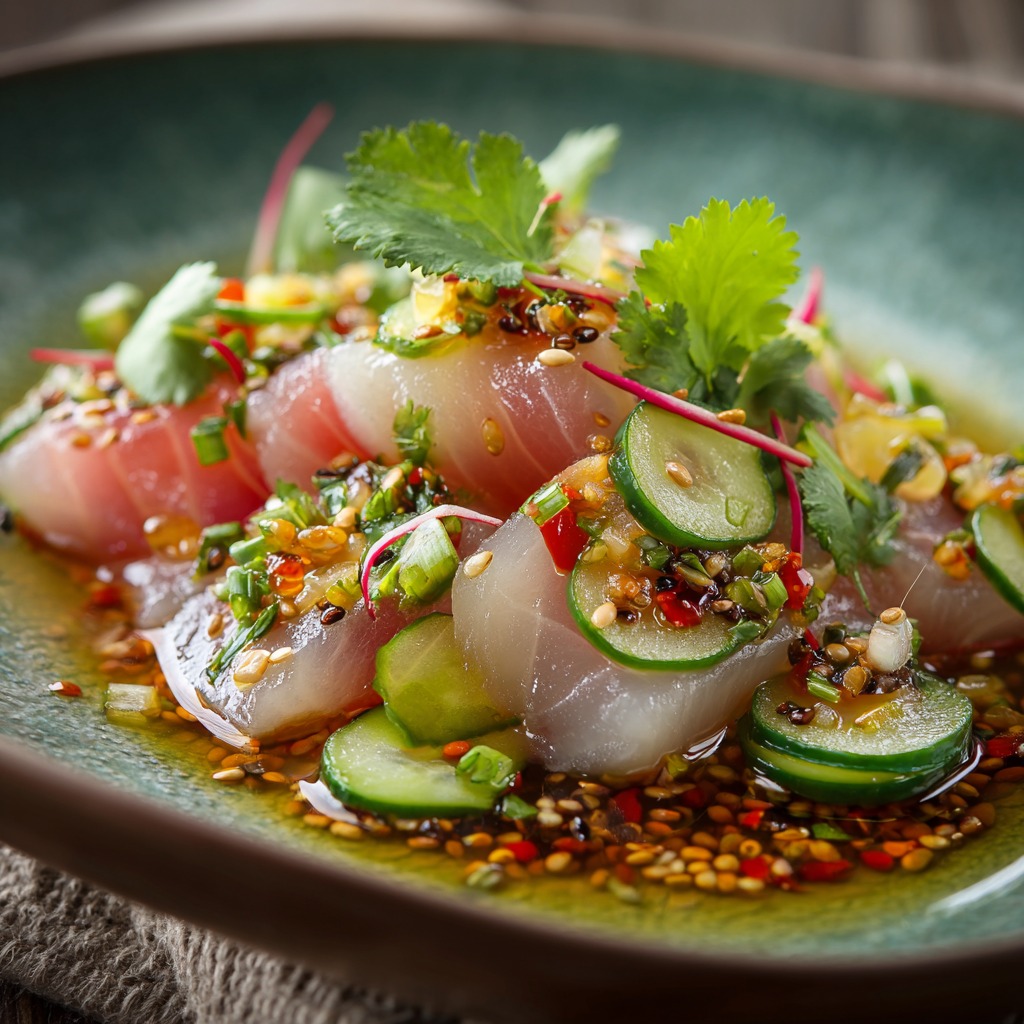
Recommended Beverages
Cocktails: A citrus-based cocktail like a gin and tonic or mojito also complements the bright, fresh notes of the crudo.
White Wine: A crisp, light white wine like Sauvignon Blanc or Chardonnay works well with hamachi crudo.
Sake: A chilled glass of sake is a traditional pairing, enhancing the dish’s subtle umami flavors.
Health Benefits of Hamachi Crudo
| Nutrient | Amount per 3 oz of Hamachi | Health Benefit |
|---|---|---|
| Protein | 23g | Supports muscle growth, tissue repair, and overall body function. |
| Omega-3 Fatty Acids | 2,500mg | Promotes heart health, reduces inflammation, and supports brain function. |
| Vitamin D | 1,000 IU | Essential for bone health, immune system support, and calcium absorption. |
| Vitamin B12 | 2.4mcg | Vital for red blood cell formation and nerve health. |
| Selenium | 35mcg | Acts as an antioxidant and supports immune system function. |
| Iron | 0.6mg | Supports oxygen transport and red blood cell function. |
Nutrient-rich fish like hamachi provide health benefits, which makes hamachi crudo very appealing to health-conscious people.
Variations of Hamachi Crudo to Try
Spicy Hamachi Crudo
For those who like a bit of heat, add sriracha or thinly sliced fresh chili peppers on top of your crudo. The spicy element balances the sweetness of the hamachi and adds complexity.
Hamachi Crudo with Ponzu or Soy Sauce
Drizzle ponzu sauce or soy sauce for an added umami kick. Ponzu adds a tangy citrus flavor that enhances the fish’s natural taste, while soy sauce brings depth.
Hamachi Crudo with Avocado and Cucumber
For a refreshing twist, pair your hamachi crudo with creamy avocado slices and crisp cucumber ribbons. The textures and flavors complement the fish perfectly.
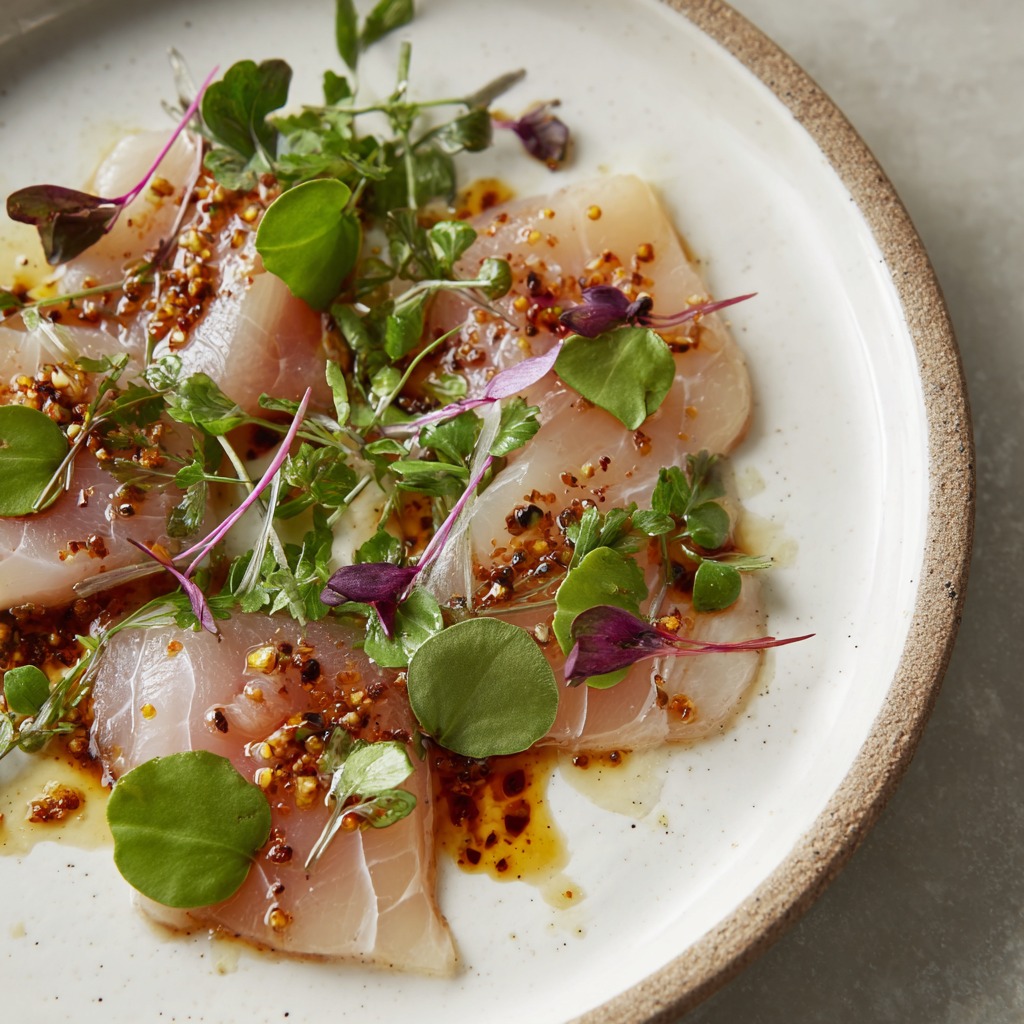
Frequently Asked Questions About Hamachi Crudo
Is Hamachi Safe to Eat Raw?
Yes, hamachi is safe to eat raw as long as it is fresh and properly handled. Be sure to purchase from a reputable source that sells sushi-grade fish.
Can You Make Hamachi Crudo Ahead of Time?
It’s best to make hamachi crudo fresh, as raw fish can degrade in quality over time. However, you can prep the ingredients (slice the fish, prepare garnishes) ahead of time and assemble just before serving.
Can I Substitute Hamachi for Another Fish in Crudo?
Yes! If you can’t find hamachi, you can substitute with other fatty fish like yellowtail tuna, salmon, or snapper. Just make sure the fish is of high quality and sushi-grade.
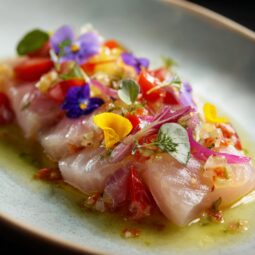
Name Hamachi Crudo Recipe
Equipment
- Sharp Knife (for slicing fish thinly)
- Chilled Plate (to serve the crudo)
- Small Bowl (for mixing oil and seasoning)
- Citrus Juicer (for extracting fresh juice)
- Measuring Spoons (for accurate seasoning)
- Spoon (for drizzling olive oil and citrus)
Ingredients
- Fresh Hamachi yellowtail tuna – 6 oz, thinly sliced
- Olive Oil – 1 tablespoon extra virgin recommended
- Lime or Lemon Juice – 1 tablespoon freshly squeezed
- Sea Salt – to taste
- Freshly Cracked Black Pepper – to taste
- Chili Pepper optional – 1-2 slices, for heat
- Microgreens or Fresh Herbs optional – for garnish
- Edible Flowers optional – for decoration
- Ponzu Sauce optional – 1 tablespoon, for added umami flavor
- Avocado optional – ½, thinly sliced for creaminess
- Radishes optional – thinly sliced for a crunchy contrast
Instructions
- Prepare the Fish: Using a sharp knife, slice the hamachi into thin, bite-sized pieces, approximately 1/4 inch thick. Arrange the slices in a circular or overlapping pattern on a chilled plate.
- Make the Dressing: In a small bowl, combine olive oil, lime or lemon juice, sea salt, and freshly cracked black pepper. Whisk until well blended.
- Drizzle and Season: Drizzle the olive oil and citrus mixture evenly over the sliced hamachi. Be careful not to drown the fish lightly coat it.
- Garnish: Add optional garnishes, such as chili pepper slices, microgreens, or edible flowers. You can also add thin avocado slices and radishes for additional texture.
- Serve: Serve immediately, or chill for 5-10 minutes to enhance the flavors. If desired, drizzle with ponzu sauce for extra flavor.
Notes
- Freshness is Key: Always use the freshest fish possible for crudo. Look for sushi-grade or sashimi-grade hamachi.
- Customization: Feel free to experiment with different toppings such as sesame seeds, wasabi, or fresh herbs like basil or cilantro.
- Substitutes: If hamachi is unavailable, yellowtail tuna, snapper, or even salmon can be good alternatives.
- Serving Suggestions: Serve as an appetizer alongside light salads or crisp white wines for a perfect meal pairing.
- Storage: This dish is best enjoyed fresh but can be prepared up to 30 minutes in advance. However, do not store leftovers as raw fish tends to lose its texture and flavor when refrigerated.

Conclusion
In closing, this hamachi crudo recipe is uncomplicated but sophisticated enough to show off the pristine qualities of fresh sashimi. The combination of presentation, crunch, and positive nutrition reinforces this dish’s versatility to any audience. The described techniques render this dish easily achievable. This is positively a dish to treasure, whether you are a novice or an established chef. Take pride in the knowledge of preparing and presenting this delightful hamachi crudo to your loved ones.

